Scapula Fracture
Updated:
(Also known as Fractured Scapula, Shoulder Blade Fracture, Fractured Shoulder Blade)
What is a scapula fracture?
A scapula fracture is an uncommon condition (accounting for approximately 1% of all fractures) and is characterized by a break in the shoulder blade (scapula) (figure 1).
Each shoulder blade lies on the upper aspect of the back of the rib cage. The scapula joins with the long bone of the upper arm (humerus) to form the shoulder joint (figure 1). It also forms a joint with the collar bone (clavicle) at the front of the shoulder (called the AC joint – Figure 2) and has extensive muscular attachments.
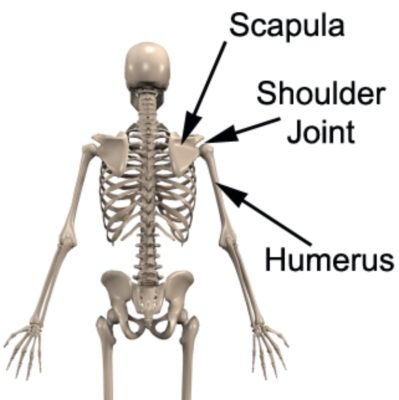
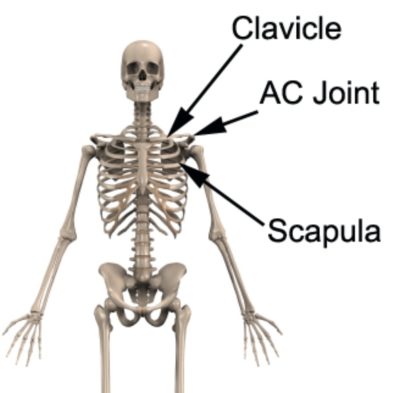
During a fall onto the shoulder blade or during a direct impact to the back or side of the shoulder, stress is placed on the scapula. If these forces are beyond what the scapula can withstand, a break in the bone may occur. When this occurs the condition is known as a scapula fracture and can vary in severity and location.
A scapula fracture may occur in various locations including:
- the body of the scapula
- bony prominences of the scapula situated at the front or side of the shoulder (coracoid and acromion processes)
- the glenoid fossa (i.e. the socket of the “ball and socket” joint of the shoulder)
Causes of a scapula fracture
A scapula fracture usually occurs due to a direct blow to the shoulder blade, such as a motor vehicle accident, a hard ball impact in sports such as cricket or hockey, or a heavy collision with another player in contact sports such as rugby or football.
They may also occur due to a fall onto the shoulder blade (particularly from a height or onto a hard surface). Occasionally a scapula fracture may occur due to a fall onto a bent elbow or outstretched arm or in association with a dislocated shoulder (this is more so the case with fractures to the glenoid fossa).
Signs and symptoms of a scapula fracture
Patients with a scapula fracture typically experience a sudden onset of sharp, intense pain at the time of injury. Pain is usually severe and located at the back or side of the shoulder, or, in the upper back. Occasionally pain may radiate into the front of the shoulder, the neck, upper arm or less commonly, the forearm or hand.
Pain may increase when attempting to perform movements of the upper limb such as arm elevation (to the front or side of the body), overhead activities, taking the arm across the chest or during pushing, pulling, reaching, carrying or lifting activities. Pain may also increase when lying on the affected shoulder blade, applying pressure to the shoulder, or on firmly touching the scapula at the site of injury. Sometimes deep breathing or coughing may also elicit pain. An ache in the shoulder or shoulder blade may also be present that is particularly prominent at night or first thing in the morning (especially during the first few days following injury).
Patients with this condition may have noticed an audible sound at the time of injury such as a ‘click’, ‘pop’ or ‘snap’. There is usually swelling at the site of injury and depending on the severity, a bony deformity may be evident. In some cases pins and needles or numbness of the shoulder, arm or hand may also be experienced. Extensive bruising to the shoulder blade region, shoulder, or upper arm may also be present (particularly with more severe fractures) and usually begins to appear a couple of days after the injury.
Diagnosis of a scapula fracture
A thorough subjective and objective examination from a physiotherapist or doctor is important to assist with diagnosis of a scapula fracture. An X-ray is required to confirm diagnosis and rule out other conditions (such as a rib fracture, clavicle fracture or dislocated shoulder) and should always be taken if a fracture is suspected clinically. Further investigation such as a CT scan or MRI might be indicated, in some cases, to confirm diagnosis and determine involvement of other structures.
Treatment for a scapula fracture

Members Only ContentBecome a PhysioAdvisor Member to gain full access to this exclusive content. For more details see Become a Member. Already a member? Login Now
Prognosis of a scapula fracture
Patients with a scapula fracture usually make a full recovery with appropriate management (whether surgical or conservative). Return to activity or sport can usually take place in a number of weeks to months and should be guided by the treating physiotherapist and specialist. In patients with severe injuries involving damage to other bones, soft tissue, nerves or blood vessels, recovery time may be significantly prolonged with long term prognosis affected (particularly in the elderly). Some patients with only very minor fractures that are un-displaced can return to sport in as little as 6 – 8 weeks (although longer periods usually lasting at least 3 – 5 months are typically required for contact sports) as guided by the orthopaedic specialist and treating physiotherapist.
In general, union (the initial healing) of a scapula fracture (i.e. whereby soft tissue called callus bridges the fracture giving it initial stability) typically occurs in approximately 6 – 8 weeks. Following union, the callus is gradually replaced with bone, with the majority of fracture strength achieved by 8 – 12 months and full fracture strength achieved around 1 – 2 years following injury.
Physiotherapy for a scapula fracture

Members Only ContentBecome a PhysioAdvisor Member to gain full access to this exclusive content. For more details see Become a Member. Already a member? Login Now
Other intervention for a scapula fracture
Despite appropriate physiotherapy management, some patients with a scapula fracture do not improve adequately and may require other intervention to ensure an optimal outcome. The treating physiotherapist or doctor can advise on the best course of management when this is the case. This may include further investigations such as X-rays, CT scan, MRI or bone scan, extended periods of sling immobilization or referral to appropriate medical authorities (such as an orthopaedic specialist) who can advise on any intervention that may be appropriate to improve the fractured scapula. In very rare circumstances, patients with fractures that are initially managed without surgical intervention may require surgery to stabilize the fracture (using plates, screws or wires) and sometimes a bone graft (to aid fracture healing).
Exercises for a scapula fracture
The following exercises are commonly prescribed to patients with a scapula fracture following confirmation that the fracture has healed or that pain free mobilization can commence as directed by the orthopaedic specialist, physiotherapist or doctor. You should discuss the suitability of these exercises with your physiotherapist prior to beginning them. Generally, they should be performed 3 times daily and only provided they do not cause or increase symptoms.
Your physiotherapist can advise when it is appropriate to begin the initial exercises and eventually progress to the intermediate, advanced and other exercises. As a general rule, addition of exercises or progression to more advanced exercises should take place only provided there is no increase in symptoms.
Initial Exercises
In many cases, these initial exercises may begin within the first 1 – 2 weeks following injury as guided by the treating physiotherapist and provided there is no increase in pain due to the exercises. Exercises involving uninvolved joints below the fracture level such as the elbow, wrist and hand, can usually commence within the first 1 – 2 days following injury as guided by the treating physiotherapist.
Hand Open and Close
Curl your fingers and thumb making a tight fist then straighten your fingers as far as possible provided the exercise is pain free (figure 3). Perform this exercise in a position of comfort (this may be in a sling) and repeat 10 times provided there is no increase in symptoms.
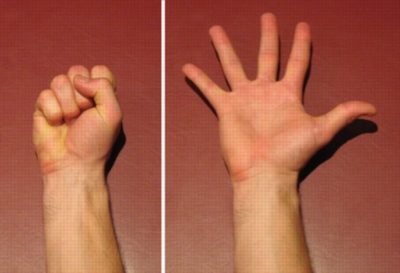
Wrist Flexion to Extension
Begin this exercise in a position of comfort (this may be in a sling) or sometimes with your forearm supported by a table, bench, your opposite hand or pillow etc. Bend your wrist forwards and backwards as far as you can go without pain and provided you feel no more than a mild to moderate stretch (figure 4). Repeat 10 times provided there is no increase in symptoms.
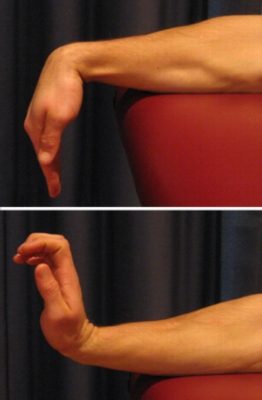
Elbow Bend to Straighten
Begin this exercise in a position of comfort (often beginning with your forearm and palm on your chest). Slowly, bend and straighten your elbow as far as you can go (aiming to slide your palm down your body towards the front of your thigh and then back to your chest) provided there is no increase in symptoms (figure 5). Repeat 10 times provided the exercise is pain free.
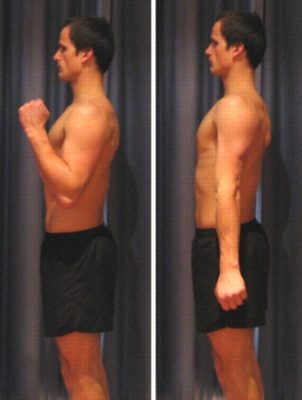
Pendular Exercises
Begin this exercise by leaning forwards with your unaffected arm supported on a table or bench (figure 6). Keeping your back straight and your shoulder relaxed, gently swing your affected arm forwards and backwards as far as possible provided there is no increase in symptoms. Repeat 10 times. Repeat the exercise swinging your arm side to side as far as possible provided there is no increase in symptoms.
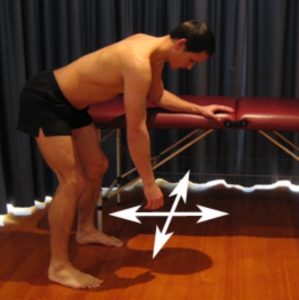
More Initial Exercises

Members Only ContentBecome a PhysioAdvisor Member to gain full access to this exclusive content. For more details see Become a Member. Already a member? Login Now
Intermediate Exercises

Members Only ContentBecome a PhysioAdvisor Member to gain full access to this exclusive content. For more details see Become a Member. Already a member? Login Now
Advanced Exercises

Members Only ContentBecome a PhysioAdvisor Member to gain full access to this exclusive content. For more details see Become a Member. Already a member? Login Now
Other Exercises

Members Only ContentBecome a PhysioAdvisor Member to gain full access to this exclusive content. For more details see Become a Member. Already a member? Login Now
Rehabilitation Protocol for a Scapula Fracture

Members Only ContentBecome a PhysioAdvisor Member to gain full access to this exclusive content. For more details see Become a Member. Already a member? Login Now
 Physiotherapy products for a scapula fracture
Physiotherapy products for a scapula fracture
Some of the most commonly recommended products by physiotherapists to hasten healing and speed recovery in patients with a scapula fracture include:
-
 Wheat Bags
Wheat Bags -
 OPPO – Posture Aid / Clavicle Brace (OPP2075)
OPPO – Posture Aid / Clavicle Brace (OPP2075) -
 AllCare Band
AllCare Band -
 Premium Strapping Tape 38mm (Victor)
Premium Strapping Tape 38mm (Victor) -
 AllCare Pro-TENS Machine
AllCare Pro-TENS Machine -
 AllCare Tubing
AllCare Tubing -
 AllCare Spikey Massage Ball
AllCare Spikey Massage Ball -
 AllCare Instant Cold Pack (15 x 25cm)
AllCare Instant Cold Pack (15 x 25cm) -
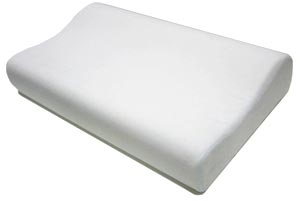 Dentons Impressions Classic Memory Foam Therapeutic Pillow
Dentons Impressions Classic Memory Foam Therapeutic Pillow -
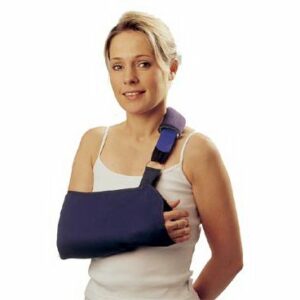 Actimove Arm Sling (Mitella)
Actimove Arm Sling (Mitella)
To purchase physiotherapy products for a scapula fracture click on one of the above links or visit the PhysioAdvisor Shop.
 More Exercises
More Exercises
- Shoulder Stretches.
- Shoulder Strengthening Exercises.
- Scapular Stability Exercises.
- Rotator Cuff Strengthening Exercises.
- Elbow Stretches.
- Elbow Strengthening Exercises.
- Neck Stretches.
- Postural Exercises.
- Arm Strengthening Exercises.
- Upper Body Machine Weights.
- Cable Exercises (Back & Biceps)
- Cable Exercises (Chest, Shoulders & Triceps).
- Free Weights (Back & Biceps).
- Free Weights (Chest, Shoulders & Triceps).
- Cardiovascular Exercise.
 Recommended Reading
Recommended Reading
- Posture.
- Postural Taping.
- Ice or Heat.
- The R.I.C.E. Regime.
- Injury Prevention.
- Investigations
- Understanding Pain
- Returning to Sport.
- Warming Up and Cooling Down
- Why is My Injury Not Improving?
- Shoulder Diagnosis Guide.
 Find a Physio for a scapula fracture
Find a Physio for a scapula fracture
Find a physiotherapist in your local area who can treat a scapula fracture.
Become a PhysioAdvisor Member

Link to this Page
If you would like to link to this article on your website, simply copy the code below and add it to your page:
<a href="https://physioadvisor.com.au/injuries/shoulder/scapula-fracture”>Scapula Fracture – PhysioAdvisor.com</a><br/>PhysioAdvisor's detailed physiotherapy information on a scapula fracture includes: causes, symptoms, diagnosis, treatment, exercises, rehabilitation & more
Return to the top of Scapula Fracture.

